The Apollo Justice trilogy on PlayStation, Xbox and Switch is the best Ace Attorney remaster to date
A high-quality collection that should satisfy series fans.
The Ace Attorney games provide some of the most captivating storytelling in gaming. Set in crime scenes and courtrooms, these titles revolve around defending clients while trying to solve cases in abbreviated and eccentric legal proceedings. 2019 and 2021 saw a selection of these portable games released for home consoles, and now to start 2024 we have the final mainline titles hitting PS5, Series X/S and Switch with Apollo Justice: Ace Attorney Trilogy.
Those previous re-releases, Phoenix Wright: Ace Attorney Trilogy and The Great Ace Attorney Chronicles, suffered from their share of technical failings, so does the new game learn from those mistakes and make full use of the console hardware available? And what tweaks and additions can returning players expect?
To start, we're comparing the new port on PS5 against the iPhone port of the original Apollo Justice: Ace Attorney game from 2007 - and differences are evident from the moment the game begins. The opening cutscene has been adapted from 4:3 to a wider 16:9, with the framing punched in to cut off the top and bottom of the image. The underlying sequence here seems to be based off scaling and panning sprites, with occasional bits of pre-rendered video mixed in. The new games do use reasonably high quality assets here, even if the cutscenes do look primitive by modern standards.
During gameplay, again we see the same cropping of the background scene to accommodate 16:9 displays. It would have been great if these scenes had been expanded with additional art, but this solution mostly works well. Character sprites are sometimes punched in too, but if they're sufficiently separated from the background they're usually scaled the same as before. Often, they're moved around a bit in the scene, especially if there's a foreground element like a lectern or desk.
Relative to the iPhone version, the sprite art does look better here, although it's hard to tell how much has changed beyond the output resolution as the iPhone code looks a little fuzzy. The characters and backgrounds are drawn at 1080p and scaled using a nearest-neighbour technique to a 4K output. This helps to keep the image sharp, at the cost of some visible pixelation. The UI is rendered at 4K though, thankfully.
Apollo Justice featured 3D object manipulation, and that's been replicated here as well. Gone is the dial-based stylus-centric interface, with analogue stick controls instead. The actual 3D assets have seen a bit of a makeover too, with revamped texture work, new geometry and no black outline effect as we saw in the original games. The 3D elements do render at 4K here as well.
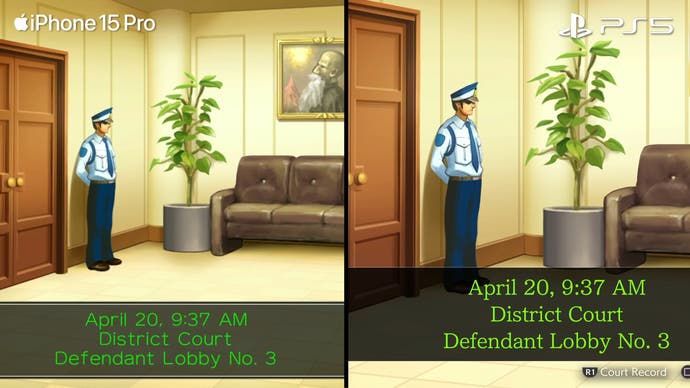

Ace Attorney: Dual Destinies was released in 2013 for the Nintendo 3DS. If we compare the emulated 3DS game at 6x resolution scale with the new release, we start to see some of the fundamental differences at play here.
The opening cutscene, which is a 3D video on 3DS hardware, looks vastly higher quality in the new version. It's not super sharp - I wouldn't be surprised if it's ~720p - but it looks perfectly presentable on a TV, which I can't say for the 3DS code. It's also presented in full-screen without letterboxing, while the 3DS has slight black bars on the top and bottom of the display to accommodate its 15:9 aspect ratio.
Gameplay presents some curious differences. There are some subtle tweaks, like how the screen is slightly cropped in for aspect ratio purposes, and some little details have been tweaked such as the framing of characters against the background. However, in the courtroom segments with foreground elements, the character framing is the same as before.
Even though the camera in Dual Destinies tends to be very static, the game actually uses a mix of 3D and 2D elements for its backgrounds. If you look closely, you can spot a few tweaks to some meshes, with more finely rounded detail in the new version. I couldn't spot any polygonal tweaks to the 3D character models, but they do sport visibly higher resolution texture art. The actual rendering resolution of the new code seems to be 4K, which helps deliver a pristine rendition of the 3D artwork, although some background elements count at 1080p.
The iPhone version is mostly the same as the 3DS in this title, but it renders at a lower resolution relative to the resolution-enhanced emulated code. The iPhone actually does preserve the 15:9 letterboxing for the main game content, so the image isn't cropped like the new versions. The only difference of note is that the anime cutscenes look a lot better here than on the 3DS version, with quality falling just a bit short of the new Apollo Justice Trilogy port.
For 2016's Ace Attorney: Spirit of Justice, Capcom pushed out their 3D chops quite a bit, and the entry includes more full-body movement and fully animated dioramas. The changes and overall presentation here are pretty similar to what we saw in Dual Destinies. For example, background artwork is tweaked with higher-resolution 2D elements outdoors.

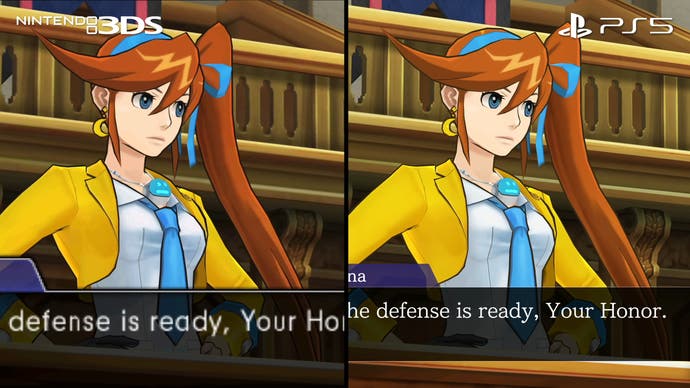
Some bits of the background here are drawn with slightly different proportions, where it looks like the existing artwork has been warped slightly to achieve a different look. We also see revised assets in places elsewhere, such as higher-res calligraphy in some background shots. If you compare the two versions side-by-side, you can spot a lot of these little revisions and resolution bumps in the artwork, which make the new game look substantially more refined at high resolutions.
So that's the PS5 accounted for, but what about the other platforms? Technically, it's worth noting that this is a last-generation title only, so on PS5 and Xbox Series hardware the games are running under backwards compatibility... though I don't expect there will be any meaningful differences on last-gen consoles.
Series X runs the 3D Ace Attorney entries at 4K, just like the PS5, and is otherwise visually identical. Series S though appears to render at just 1080p as it's still on the Xbox One codepath, which is a shame as 4K ought to have been possible with a native Series release. That means a bilinear scale is used when the Series S console is set to 4K output, which does compromise the sharpness of the artwork somewhat relative to the other versions.

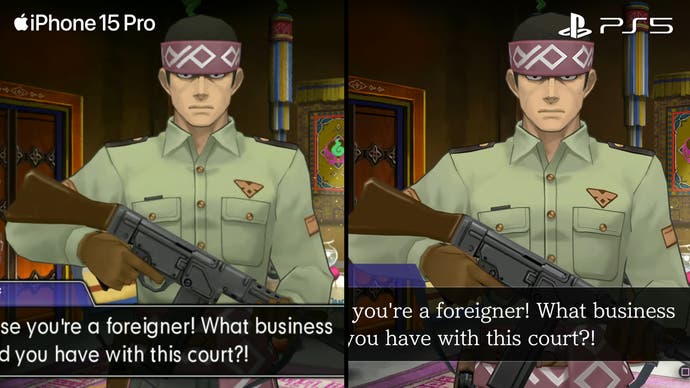
At resolutions this high though, I'm not sure the art holds up that well. The original titles were designed with very low resolutions in mind, which helped to mask some of the simplicity of the artwork. Even the 3DS entries, with their 400x240 resolution per eye, were operating just above the typical resolution of most PS1 or N64 titles. When blown up to 4K, I do think something is lost slightly in translation, even with touched-up art, as the pixel structure inherent to the DS consoles gives these titles a more natural look.
That brings us neatly to the Nintendo Switch. Here, we have the option to play the game in portable mode, which helps hide more of those visual flaws. Resolution-wise, we're looking at a native 720p on the Switch handheld screen, while docked play steps up to a full 1080p output. Visually, I couldn't spot any other differences between the Switch and home console versions, and the Switch comes in with a similar download size as the other console systems so video sequences have good quality as well. These aren't exactly the most demanding titles, but it's good to see Switch parity here.
Performance is decent, although the frame-time read-out can look spiky as some frames have no animation whatsoever - thankfully this isn't meaningful in practice. When there is continuous camera movement or background animation, the games present a stable 30fps update, generally speaking. The anime-style cutscenes do exhibit a lot of uneven movement, however. These are animated at 24fps but seem to be encoded at 30fps, making for a jerky look relative to the 3DS. Animation frames are displayed for either two or four refreshes of the display, while the 3DS displays frames for two or three refreshes.
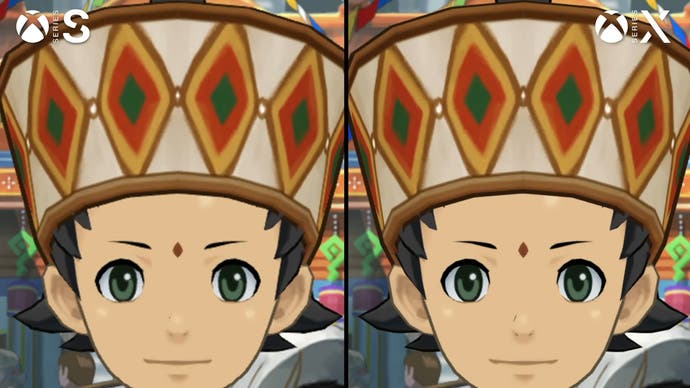
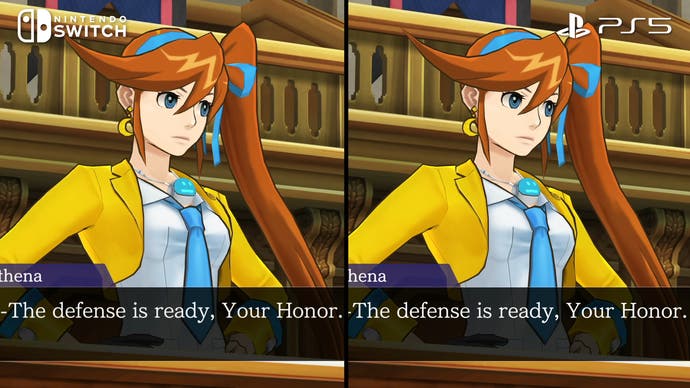
I didn't notice any differences between the platforms here, except that the Switch seems to register frame-pacing problems in some animated sequences that the other platforms don't have. In general though, performance is about where it should be. Interestingly, on an emulator we can get the 3D Ace Attorney games to run at 60fps fairly easily, although I'm not sure if this could have caused issues elsewhere for the remastered games.
Overall, this new release offers pretty effective remasters of these titles. The artwork mostly looks presentable, even if clearly not designed for the scrutiny of high-resolution rendering. Apollo Justice's reworked art is decent enough, and the 3D art in the sequels looks bold and crisp, with enough touch-ups to keep it presentable.
The overall interface is pretty slick as well, with a good central menu to navigate between the three games and some nice UI art. The interface changes are mostly welcome and I liked the addition of an auto-play feature for text playback, although I think the change from sans-serif to serif fonts might annoy some. The games also work just fine without the touch controls of the original titles, as the analog sticks prove a fine replacement. On Switch, touch controls are supported in portable mode, although there's no touch-specific interface.
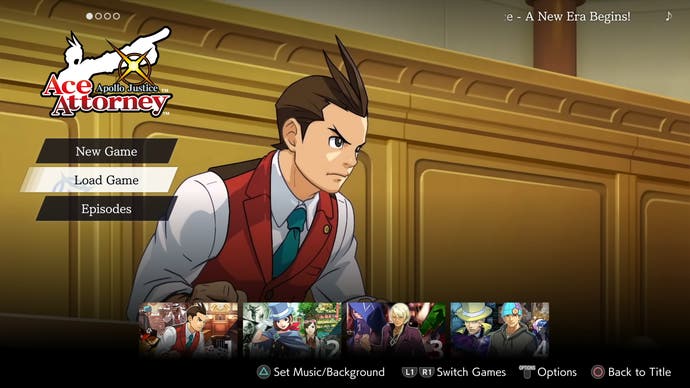
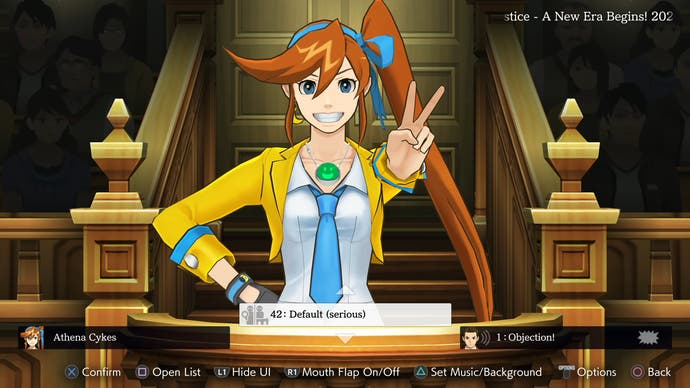
There's a healthy chunk of side content to round out the experience too, which includes an extensive music selection, a variety of art, and an animation playback area, which seems destined for memes. There's a great selection of stuff to gawk at here for series fans, and some cool unlockables as well.
Ultimately, I think this is the best Ace Attorney remaster to date. The Phoenix Wright Ace Attorney trilogy had redrawn artwork that didn't quite hit the mark, with a softly-shaded and low-detail style that didn't look great at high resolutions. The Great Ace Attorney Chronicles was slick and well-put together in contrast, but disappointingly only rendered at 1080p on PS4 Pro and PS5. This collection basically arrives without caveats, and the games are presented very effectively.
The three games in this collection are some of the best Ace Attorney games out there in my opinion as well. The difficulty curve of the original trilogy - which could be pretty steep at times - has mostly been eased off, as the games have less of a trial-and-error feel to them, and you have a firmer sense of how to progress through any given investigation. The characters and new mechanics are top-notch, and the last two entries have excellent production values. I think Apollo Justice is a perfectly reasonable place to start for a new player too, as Ace Attorney games are fairly stand-alone, though some understanding of the plot of the original trilogy would definitely be helpful.
I do hope a new Ace Attorney title is planned, especially after three remaster packages and seemingly some renewed interest from Capcom. But until then, this is a high-quality collection that should satisfy series fans.
.jpg?width=690&quality=75&format=jpg&auto=webp)








